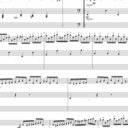[Oral single-dose and 13-week repeat-dose toxicity studies of RCC-36, the active metabolite of (+/-)-4-diethylamino-1,1-dimethylbut-2-yn-1-yl 2-cyclohexyl-2-hydroxy-2-phenylacetate monohydrochloride monohydrate(NS-21), a novel drug for urinary frequency and incontinence, in rats].
Từ khóa
trừu tượng
Oral single-dose and 13-week repeat-dose toxicity studies of (+/-)-4-ethylamino-1, 1-dimethylbut-2-yn-1-yl 2-cyclohexyl-2-hydroxy-2-phenylacetate monohydrochloride (RCC-36), an active metabolite of (+/-)-4-diethylamino-1,1-dimethylbut-2-yn-1-yl 2-cyclohexyl-2-hydroxy-2-phenylacetate monohydrochloride monohydrate (NS-21), a new drug for the treatment of urinary frequency and incontinence, were conducted in male and female Sprague-Dawley rats. In the single-dose toxicity study, rats were given the drug at doses of 0 (control), 400, 600, 900, 1350 and 2030 mg/kg. In the 13-week repeat-dose toxicity study, rats were given the drug for 13 weeks at doses of 0 (control), 3, 30 and 300 mg/kg. After discontinuation of the treatment, a 5-week recovery test was also conducted. In the single-dose toxicity study, death occurred in the 600 mg/kg group and over, and LD50 values were 735 mg/kg in both sexes. The major clinical signs observed following the administration of this drug were mydriasis, salivation, decreased spontaneous locomotor activity, ataxic gait, lacrimation and urorrhea in the 400 mg/kg group and over, hypopnea and soft feces in the 600 mg/kg group and over. In addition, prone or lateral position and tonic or clonic convulsion were observed in the dead animals. Rats showed a decrease in body weight or a suppression of its weight gain in the 400 mg/kg group and over. Macroscopic findings in the dead animals were congestion in lung and retention of foamy mucinous fluid in trachea. The animals alive showed no abnormalities attributable to the treatment. In the 13-week repeat-dose toxicity study, 13 cases of death occurred in the 300 mg/kg group. Main pathological findings in these cases were congestion and edema in lung. Mydriasis was seen in the 30 mg/kg group and over. Lacrimation, salivation, wheezing, emaciation [corrected] wasting and unkempt fur were seen in the 300 mg/kg. A suppression of body weight gain and a decrease in food consumption were observed in the 300 mg/kg group. An increase in water consumption was seen in the 30 and 300 mg/kg groups. Ophthalmologic examination confirmed the mydriasis in the 30 mg/kg group and over. Urinalysis showed an increase in urine volume and a decrease in Na+ excretion in the 30 and 300 mg/kg groups and decreases in K+ and Cl- excretions in the 300 mg/kg group. Hematological examination showed decreases in hemoglobin, hematocrit, MCV and MCH, and an increase in MCHC in the 300 mg/kg group. Blood chemical examination showed decreases in triglyceride and glucose, and an increase in total protein in the 300 mg/kg group. Pathological examination disclosed hepatocellular hypertrophy associated with hyperplasia of smooth-ER, a decrease in number of glycogen granules and an increase in number of lipofuscin in the 300 mg/kg group. Stimulated thyroid follicles were seen in the 300 mg/kg/group. In kidney, an increase in number of hyaline droplets in the proximal tubular epithelium, in which lysosomes and dense bodies were increased, was observed in the 300 mg/kg group. Dense bodies were increased also in the glomerular epithelium. In this dose group, adrenocortical hypertrophy was also observed. The recovery test showed that the above-mentioned changes were satisfactorily reversible or the degree and frequency of these changes were lowered. No treatment-related effects were seen in the 3 mg/kg group. These results show that the NOAEL (no observed adverse effect level) of RCC-36 is 3 mg/kg for 13-week oral toxicity in rats.


